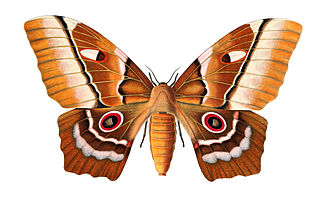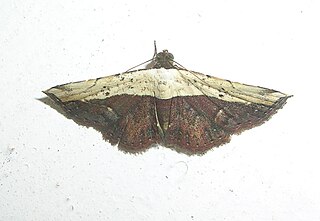Related Research Articles

Gracillariidae is an important family of insects in the order Lepidoptera and the principal family of leaf miners that includes several economic, horticultural or recently invasive pest species such as the horse-chestnut leaf miner, Cameraria ohridella.
Metachanda is the sole genus in tribe Metachandini of moth subfamily Oecophorinae. Metachandini was originally described as family Metachandidae by Edward Meyrick in 1911, and at the time also contained the genus Chanystis, which is currently unplaced to tribe within Oecophorinae. It has also previously been described as tribe Metachandini of subfamily Gelechiinae.

The Obtectomera is a clade of macro-moths and butterflies, comprising over 100,000 species in at least 12 superfamilies.

Sufetula is a genus of moths of the family Crambidae.

Ericeia is a genus of moths in the family Erebidae. The genus was erected by Francis Walker in 1858.

Eois is a genus of moths in the family Geometridae. The genus contains about 250 validly described species, most from the Neotropical region. Many species are still undescribed and the total number of species is estimated to be over a 1,000 in the Neotropical region alone. The genus was first described by Jacob Hübner in 1818.

Pseudimbrasia is a monotypic moth genus in the family Saturniidae described by Pierre Claude Rougeot in 1962. Its only species, Pseudimbrasia deyrollei, described by James Thomson in 1858, is found in the mid-latitudes of Africa.

Uresiphita polygonalis is a moth of the family Crambidae. The species was described by Michael Denis and Ignaz Schiffermüller in 1775. It is found in the Pacific, including Hawaii and New Zealand, Sri Lanka, Europe and northern and southern Africa.

Oruza divisa is a species of moth of the family Erebidae first described by Francis Walker in 1862. It is found in Asia, including Hong Kong, Sri Lanka, Sulawesi, Taiwan, Japan and in Africa south of the Sahara, including Indian Ocean islands.

Hymenia perspectalis, the spotted beet webworm moth, is a species of moth of the family Crambidae. It is found in various parts of the world, including North America, where it is found from Maine to Florida, west to Texas and north to Michigan and Ontario. It is also found in Belize, Hong Kong, Jamaica, Australia (Queensland), the Comoros, Equatorial Guinea, Réunion and South Africa. The species was described by Jacob Hübner in 1796.

Hipoepa fractalis is a species of moth of the family Noctuidae first described by Achille Guenée in 1854. It is found in Taiwan, China, Japan, Kenya, Korea, India, Malaysia, Nigeria, Indonesia, the Philippines, Thailand, Cape Verde, Réunion, Saudi Arabia, South Africa, Sri Lanka, Uganda, Yemen and Australia.

Orphanostigma abruptalis is a moth of the family Crambidae. The species was first described by Francis Walker in 1859. It occurs in the tropics of the Old World from Africa to Australia.

Hypena obacerralis is a moth of the family Erebidae. It is found throughout Africa, the Middle East and South Asia and Malaysia.

Scopula minorata is a moth of the family Geometridae. It was described by Jean Baptiste Boisduval in 1833. It is found in Africa south of the Sahara, the Arabian Peninsula and on the islands of the Indian Ocean. Furthermore, it is found in southern Europe. It can be distinguished from Scopula lactaria only by examination of its genitalia.

Aethaloessa calidalis is a moth of the family Crambidae described by Achille Guenée in 1854. It is found throughout the Seychelles, South and South-East Asia, Australia and on many Pacific islands.
Rhynchina obliqualis is a moth of the family Erebidae first described by Vincenz Kollar in 1844. The type locality is Mussoorie, in the Indian Himalayas.
Euchromia folletii, the South African day-flying moth, is a species of moth of the subfamily Arctiinae. It was described by Félix Édouard Guérin-Méneville in 1832. It is found on the Comoros and Seychelles, as well as in Ethiopia, Kenya, Madagascar, Mozambique, Senegal, Sierra Leone, South Africa and Tanzania.

Cnaphalocrocis trapezalis is a species of moth of the family Crambidae described by Achille Guenée in 1854. It can be found from Africa to the Pacific region, including Australia as well as in the Dominican Republic, Mexico and Peru.
The Macroheterocera are a well supported clade of moths that are closely related to butterflies and other macro-moths.
References
- ↑ De Prins, J. & De Prins, W. (2018). "Phasmatilema stevensii (Holland, 1892)". Afromoths. Retrieved October 24, 2018.
- Pitkin, Brian & Jenkins, Paul. "Search results Family: Arctiidae". Butterflies and Moths of the World. Natural History Museum, London.